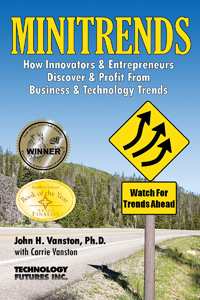Zynga Founder Mark Pincus on Entrepreneurial Success
October 29, 2010
 What is the secret ingredient for successful entrepreneurship? There is one, according to John and Carrie Vanston, authors of the new book, MINITRENDS: How Innovators & Entrepreneurs Discover & Profit From Business & Technology Trends. And it’s not what you might think.
What is the secret ingredient for successful entrepreneurship? There is one, according to John and Carrie Vanston, authors of the new book, MINITRENDS: How Innovators & Entrepreneurs Discover & Profit From Business & Technology Trends. And it’s not what you might think.
Is it tenacity? Nope. Drive? No. Training? Not a major ingredient. Neither is education, wealth, creativity or connections. None of these things show a very strong correlation with entrepreneurial prowess.
Surprise: The one trait that ties together more successful entrepreneurs than anything else is “exceptionally good health.” That’s according to the University of Washington’s Dr. Karl Vesper, who reviewed numerous studies of entrepreneurs looking for underlying patterns.
While he might not recognize it as the most important benefit he provides to over 1,000 employees, entrepreneur Mark Pinkus knows his health and their health is important. It’s the reason his company provides not only excellent health care benefits, but also such perks as onsite dentistry and a free company cafeteria.
Pinkus, whose company, Zynga, has created such popular games as FarmVille and Mafia Wars, was interviewed recently by Kermit Pattison for Fast Company. Pattison specializes in interviews with business leaders. The way he covers Silicon Valley, you would think him a fixture in the San Francisco Bay Area. But he plies his trade from a healthy distance — out of St. Paul, Minnesota.
Asked about Zynga’s food court, Pincus explains:
I started to realize that from a productivity standpoint good food has a multiplier effect. You waste time trying to find food everyday. You feel crappy about a lot of the food you eat. There are positives about building community — food brings people together. If have enough good food in one place, it gives people from different parts of the company reason to sit down together.
Pincus is passionate about entrepreneurship. When he hires managers, he looks for people with that entrepreneurial mindset. “You can be an entrepreneur inside any size company. The best companies today value great entrepreneurs and work hard to retain them and motivate them,” Pinkus told Pattison.
MINITRENDS is built on this same premise: that one can be an entrepreneur in any size company. It’s your job to keep alert to new trends and to choose which directions to embrace and which to steer clear from, whether you are a sole proprietor, part of a small business, or a manager for a large business enterprise.
You’re not going to be successful at that job if you don’t take care of yourself. So learn the real secret of successful entrepreneurs and pay attention to your heath, because you won’t last long in this business without it.
STEVE O’KEEFE
News Editor, Minitrends Blog
Source: “Leveling Up Your Staff: Zynga’s Mark Pincus on Entrepreneurial Companies,” Fast Company, 10/27/10
Source: “Stay Healthy,” MINITRENDS, p. 179.
Image by Identity Photogr@phy (Clare Bell), used under Creative Commons license.
What’s the Hottest New Tech Trend? Ranking Hot New Tech Trends
October 28, 2010
 The National Aeronautics and Space Administration, better known as NASA, has a new mission. No, I don’t mean we’re going to Mars, although that certainly is on NASA’s radar. Rather, NASA seeks to become the information technology (IT) leader for the U.S. government.
The National Aeronautics and Space Administration, better known as NASA, has a new mission. No, I don’t mean we’re going to Mars, although that certainly is on NASA’s radar. Rather, NASA seeks to become the information technology (IT) leader for the U.S. government.
This new mission was revealed by NASA’s chief administrator Charles F. Bolden last month, when he opened NASA’s first Information Technology Summit. Among the luminaries making presentations at the summit were:
- James Stikeleather, Chief Innovation Officer, Dell Services
- Mark Bregman, Chief Technology Officer, Symantec
- David W. Cearley, Vice President and Gartner Fellow in Research, Gartner, Inc.
- Vint Cerf, Vice President & Chief Internet Evangelist, Google
- Vivek Kundra, Chief Information Officer, United States of America
NASA has kindly made the videos of these hour-long presentations freely available online. Anyone interested in IT trends is encouraged to review them. Of keen interest to Minitrends Adventurers is James Stikeleather’s take on the future of IT. Internet immortal, Alexander Wolfe, the editor-in-chief of InformationWeek.com famous for reporting on the Pentium “floating point” bug, recently spoke with Stikeleather and came away with this interesting perspective:
[…C]ompanies are attempting to codify the processes through which innovation can be nurtured. More important than ideas, which quite frankly are cheap, is the ability to pick which concepts are worthy of the heavy investment of time, money, and corporate mindshare required to take them to productization.
Leading the pack here is Dell. At the InformationWeek 500 Conference, I spoke with Chief Innovation Officer James Stikeleather, who is working to establish and spread a methodology for innovation throughout the computer powerhouse.
This desire to handicap ideas based on the ability to bring them profitably to market is at the core of MINITRENDS, the new book by John and Carrie Vanston. The authors lay out a systematic process for evaluating ideas in order to uncover those with a development time frame of two to five years.
Wolfe made his remarks in a column a few days ago on The Top 5 Tech Trends in 2011. Along with the need to grade ideas based on their short-term feasibility, Wolfe sees these as the big IT issues in the coming year:
- Data Visualization, to make sense of the overwhelming amount of information businesses are collecting and have stored up.
- Rebellion Against Maintenance Fees, by businesses that are tired of paying ransom to software companies for maintenance contracts they barely use.
- Enterprise 2.0, the integration of social networking into business enterprises, which Wolfe sees as a mixed bag but a major issue in the coming year.
- The Internet Is Making Us Stupid, by reducing attention spans to the point where reading Wolfe’s column feels like reading War and Peace.
Wolfe’s top tech list is quite a bit different from the other year-end lists we’ve been covering here on the Minitrends Blog. While most forecasters are focused on cloud computing and mobile technology, Wolfe’s list has a decidedly human element to it. He sees most trends coming not from a lust for the new, but from a need to fix a pressing problem. The Vanstons also cite alleviating pain, rather than pursuing pleasure, as a major driving force behind new technology.
As we continue our year-end look at tech trends, we’re anxious to hear your top picks. Will the hot trends for the new year propel us into a new world or shield us from it? We welcome your comments.
STEVE O’KEEFE
News Editor, Minitrends Blog
Source: NASA Information Technology Summit Videos, NASA, 08/10
Source: “Top 5 Tech Trends For 2011,” InformationWeek.com, 10/23/10
Image by http2007, used under Creative Commons license.
Resources for Life Sciences Entrepreneurs and Venture Capitalists
October 27, 2010
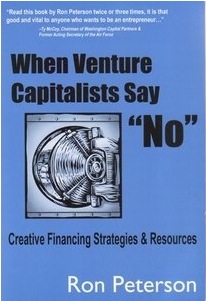 While researching trends in longevity and their significance for start-up companies, I came across an extraordinary report by investment banker Ronald Peterson. Entitled “Technology Transfer and the Life-Sciences,” the report is chock-full of two things:
While researching trends in longevity and their significance for start-up companies, I came across an extraordinary report by investment banker Ronald Peterson. Entitled “Technology Transfer and the Life-Sciences,” the report is chock-full of two things:
1. Examples of companies who have licensed technology, then made a fortune off it.
2. Contact information for anyone pursuing similar ambitions.
A veteran venture capitalist, Peterson thinks it is too slow and too risky for biotechnology companies to develop their own proprietary technology:
Arguably the best way to form a new biotechnology company (or any technology company for that matter) is to transfer a technology that has already been largely developed and form a company by adding management, marketing and other needed talent.
Peterson’s formula for success is basically the blueprint for a Minitrends Adventure. First, locate a technology to exploit. Peterson provides links to dozens of sources, including exchanges where universities list thousands of technologies available for licensing. Next, attach that technology to your own entrepreneurial marketing team. Third, fund the operation with venture capital.
While venture capital is tight these days, it is not impossible to find. Peterson wrote a book in 2003 on how to find venture capital when markets are tight. The book is currently out of print, but available used through Amazon and other retailers. It’s called When Venture Capitalists Say “No”: Creative Financing Strategies and Resources.
Technology Transfer (TT) — the Minitrends route Peterson recommends — is also a winning strategy for the organizations that license their inventions to entrepreneurs. A study by the Milken Institute shows that universities reap $6 million in licensing fees for every $1 million spent on technology transfer operations.
This amazing article by Peterson, which is as long as a book, contains resource after resource, plus example after example to get you inspired. For example, Neven Vision licensed face recognition technology developed at the University of Southern California, secured $200,000 in venture capital funding, and later sold the firm to Google for $40 million. If this article doesn’t get your entrepreneurial blood boiling, you must be in cryonic suspension.
Ronald Peterson is president of Three Arrows Capital Corp., a U.S. investment banking firm that has helped fund hundreds of emerging high-growth companies. He has over 30 years of experience on Wall Street as either a vice-president or registered representative with companies such as Merrill Lynch and Paine Webber. He can be reached at Three Arrows Capital, 7517 Westfield Drive, Suite A, Bethesda, MD 20817; 301-229-6240; fax: 301- 229-5462; email: tarrows@comcast.net.
STEVE O’KEEFE
News Editor, Minitrends Blog
Source: “Technology Transfer and the Life-Sciences,” by Ron Peterson, 01/01/08
Cover image of When Venture Capitalists Say “No”: Creative Financing Strategies and Resources is used under Fair Use: Reporting.
Electrotechnology Group Announces Lord Kelvin Awards
October 26, 2010

The program from the IEC 2010 International Conference helps members understand electricity.
Next time you plug in an appliance, take a good look at that plug. Why is it shaped like it is? Who came up with this design? Why doesn’t it start a fire when you plug it in?
The answer is the IEC, the International Electrotechnical Commission, the worldwide organization responsible for setting standards for electronic and electrical technologies. Last week, the IEC held its General Meeting in Seattle, Washington. Nearly 3,000 scientists from over 80 countries attended the gathering to learn about new trends and celebrate achievements.
The IEC covers the broad turf of “electrotechnology.” Its meeting included presentations on wind energy, nuclear energy, solar energy, wave energy, the smart grid, and electronic transportation. Attending conferences such as the IEC General Meeting is a great way to learn about Minitrends first-hand, from the scientists pioneering solutions to current problems. Even if you can’t attend, conference proceedings, speaker lists, and awards announcements offer many insights into Minitrends.
This year, the IEC awarded three Lord Kelvin medals for achievements in electrotechnology. Control Engineering magazine provided a list of this year’s winners:
Jerome E. Dennis from the US. Dennis is an expert in the area of radiation safety and laser safety and is active in the development of regulatory policies for radiation safety.
Bernard Dumortier from France. Dumortier has made contributions to the IEC in the field of industrial automation. He was instrumental in achieving agreement on internationally relevant rules and specifications for Fieldbus, the digital protocol for process automation.
Gösta Fredriksson from Sweden. Fredriksson has been instrumental in expanding the influence and importance of IECEE, which insures Conformity Testing and Certification for Electrotechnical Equipment and Components. The system enables companies to have a product tested in one country and all members will accept the resulting test certificate and report without duplicating any of the completed tests.
Earlier this year, the IEC announced its annual Edison Awards, which recognize people working within the IEC system to establish international standards. This is another fertile ground for Minitrend exploration. For example, we learn that Ron Peterson won an Edison Award for his work assessing the impact of electric, magnetic and electromagnetic fields on human beings.
If you were creating garments to protect human beings from these fields, the work of Ron Peterson’s committee might be very important to you. If you drill down far enough into the IEC website, you’ll find personal contact information for hundreds of researchers who might be able to assist with your Minitrends Adventure.
STEVE O’KEEFE
News Editor, Minitrends Blog
Source: “IEC Announces Lord Kelvin Award Winners,” Control Engineering, 10/19/10
Source: “Thomas A. Edison Award Laureates,” International Electrotechnical Commission, 09/02/10
Image from IEC 2010 Conference Program (PDF), used under Fair Use: Commentary.
Engineering Smart Foods to Combat Disease
October 25, 2010
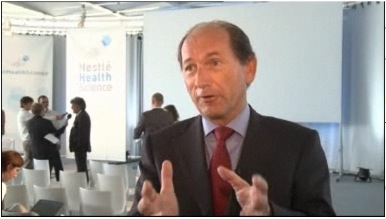
Nestlé CEO Paul Bulcke talks about the creation of Nestlé Health Science and the Nestlé Institute of Health Sciences. Click on image for the video interview.
Swiss food giant Nestlé has announced a series of major investments in developing medicinal foods that target chronic diseases. This comes as the U.S. Federal Trade Commission cracks down on Nestlé and other food companies for dubious health claims made about their products.
Nestlé CEO Paul Bulcke announced the creation of Nestlé Health Science and the Nestlé Institute of Health Sciences at a press conference on September 27, stating that the focus of the new companies will be to “prevent or correct acute chronic diseases with medicinal nutrition.”
A news release issued by Nestlé calls it a combination of “food and pharma,” and provides a list of some of the diseases being targeted:
These two separate organisations will allow Nestlé to develop the innovative area of personalised health science nutrition to prevent and treat health conditions such as diabetes, obesity, cardiovascular disease and Alzheimer’s disease, which are placing an unsustainable burden on the world’s healthcare systems.
The subject of longevity is the source of several trends mentioned in the new book, MINITRENDS, by John and Carrie Vanston. One trend resulting from increasing lifespans is the surge in the number of seniors who work. The authors state that “29% of those in their late 60s were still employed in 2006, up from 18% in 1985.” And that was before the Great Recession eroded retirement funds and home equity.
 One has to wonder about Nestle’s motives in development of these medicinal foods. Nestlé is the maker of many foods that have been linked to chronic diseases, such as childhood obesity. Nestlé was one of 17 food companies that have received letters from the Federal Trade Commission in February, warning that their ads “violated federal law by making misleading statements about disease prevention and health benefits.” Looks like Nestlé is out to bolster the science behind those claims.
One has to wonder about Nestle’s motives in development of these medicinal foods. Nestlé is the maker of many foods that have been linked to chronic diseases, such as childhood obesity. Nestlé was one of 17 food companies that have received letters from the Federal Trade Commission in February, warning that their ads “violated federal law by making misleading statements about disease prevention and health benefits.” Looks like Nestlé is out to bolster the science behind those claims.
SwissInfo.ch, who broke the story on the international wires, seems to be making commentary on the irony of the maker of candy bars now making health bars. It pairs the Nestlé announcement with a video about a government-sponsored study that shows that the “obesity among schoolchildren is increasing.”
What do you think of Nestle’s foray into the billion-dollar market of medicinal foods? Is it Trick or Treat?
STEVE O’KEEFE
News Editor, Minitrends Blog
Source: “Nestlé Health Science S.A. and Nestlé Institute of Health Sciences established to target new opportunity between food and pharma,” Nestlé Press Release, 09/27/10
Source: “Paul Bulcke, Nestlé CEO, talks about the creation of Nestlé Health Science and the Nestlé Institute of Health Sciences,” Nestlé Video, 09/27/10
Source: “Nestlé creates new bond between food and pharma,” SwissInfo.ch, 09/27/10
Source: “POM Wonderful: Not So Wonderful After All, Says the FTC,” FastCompany, 9/28/10
The Future of Futurists Is Uncertain
October 22, 2010
In a pair of interesting articles for MIT Technology Review, one of the best futurists in the business, Tom Simonite, says the future for futurists is not what it used to be. It appears that computers might be getting better at forecasting the future than futurists are.
Simonite is no slouch when it comes to predicting trends. Not only is he the IT editor for MIT Technology Review, he’s also the online technology reporter for NewScientist. On October 4, Simonite reviewed a new search technology by startup company Recorded Future that doesn’t just find what’s out there, but what will be out there, related to any search term.
The search engine works by looking at patterns of when a company says it will release a new product, for example, compared with the actual dates of product releases. The search engine can then make predictions about when a promised new technology will actually become available. Recorded Future founder Christopher Ahlberg told Simonite how it works:
[Recorded Future uses] a constantly updated index of what Ahlberg calls ‘streaming data,’ including news articles, filings with government regulators, Twitter updates, and transcripts from earnings calls or political and economic speeches. Recorded Future uses linguistic algorithms to identify specific types of events, such as product releases, mergers, or natural disasters, the date when those events will happen, and related entities such as people, companies, and countries.
In an earlier piece for MIT Technology Review, Simonite reviewed a new search technology developed by Yahoo, called “Time Explorer.” Like Recorded Future, Time Explorer searches through articles for predictions made about the future, then plots the results on a timeline so that browsers can see what is likely to occur on any given topic in the near future.
The future for Recorded Future looks bright. The company has received funding from the venture capital arms of both Google, Inc., and the Central Intelligence Agency. Being merely human, it’s hard for me to predict when this technology will be coming to a search engine near you.
STEVE O’KEEFE
News Editor, Minitrends Blog
Source: “See the Future with a Search,” MIT Technology Review, 10/4/10
Source: “A Search Service that Can Peer into the Future,” MIT Technology Review, 8/25/10
Video courtesy Recorded Future from the company’s YouTube Channel.
Intelligence Economy Has Arrived, Says Gartner Guru Sondergaard
October 21, 2010
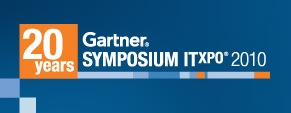 Peter Sondergaard, head of research for consulting giant, Gartner, Inc., in his opening remarks at the Gartner Symposium in Orlando, Florida, on October 18, forecast that “we are on our way to an IT-driven intelligence society,” according to Michael J. Miller on PC Magazine‘s Forward Thinking blog.
Peter Sondergaard, head of research for consulting giant, Gartner, Inc., in his opening remarks at the Gartner Symposium in Orlando, Florida, on October 18, forecast that “we are on our way to an IT-driven intelligence society,” according to Michael J. Miller on PC Magazine‘s Forward Thinking blog.
Miller is the former Chief Content Officer for Ziff Davis Media and the editor of Forward Thinking. His coverage of Sondergaard’s remarks is extensive and compelling. He quotes Gartner guru Sondergaard as saying:
By 2012, the Internet will be 75 times larger than it was in 2002.
Gartner’s Symposium doubles as an Information Technology (IT) expo. Ten days ago, Gartner released its much-hyped Hype Cycle, boosting visibility in advance of the big event. We criticized the “emerging technology” Hype Cycle here for excluding social networking.
According to Miller, Sondergaard included “social computing” in his list of the top four trends driving IT in his opening remarks. The other three are context-aware computing, pattern-based strategy, and cloud computing, which Gartner’s own HypeCycle says is “past its peak.”
Miller quotes Sondergaard:
Information will be the oil of the 21st century.
In their book, MINITRENDS, John H. Vanston and Carrie Vanston cover the Minitrend of Increasing Use of Electricity in Industrial Processes, where they discuss the concept that the value of goods increases with the amount of information contained in them:
Manufacturing can be defined as the transformation of materials from one form to another more valuable form using energy and information. In general, the greater the information content of the process, the greater the efficiency, the smaller the waste of material and energy, and the smaller the pollution-producing side streams will be. For example, sand can be used as filler for asphalt, as a component of fine china, or as a ingredient in an electronic computer chip. The basic difference between these uses is the amount of information embedded in the silicon (sand) during the production process. Electrical processes can be used to materially increase information content to material.
That mindbending little excerpt comes courtesy of the Edison Electric Institute. It’s one of the interesting trends John and Carrie have uncovered in this book.
If you are looking for a Minitrend Adventure, think about how you can increase the information content in the things around you — before someone else does.
STEVE O’KEEFE
News Editor, Minitrends Blog
Source: “Four Big Trends Changing Computing, Gartner Says,” PCMagazine, Forward Thinking Blog, 10/18/10
Source: Gartner Symposium Live Blog (SymLive), 10/17/10 – 10/21/10.
Image of the Gartner Symposium 2010 logo is used under Fair Use: Reporting.
Go Daddy Innovates an Online Advertising Minitrend
October 20, 2010
 Last week, I used the online advertising market to illustrate the difference between megatrends and Minitrends. Google has prospered tremendously from the mega-shift in advertising away from print and broadcast media. In doing so, Google has pioneered many Minitrends, including inserting fresh ads into old content.
Last week, I used the online advertising market to illustrate the difference between megatrends and Minitrends. Google has prospered tremendously from the mega-shift in advertising away from print and broadcast media. In doing so, Google has pioneered many Minitrends, including inserting fresh ads into old content.
Google isn’t the only one innovating in this space. Last week, domain registrar and host Go Daddy announced a clever new service called AdSpace that makes online advertising more accessible to small and medium-sized businesses (SMBs).
Go Daddy’s AdSpace allows entrepreneurs to fill out a simple form about their business, and Go Daddy takes it from there. The company’s online advertising experts follow this fascinating chain of activities:
- They create a web page based on the info you provide.
- Their keyword specialists then select keyphrases for your business.
- Next, they purchase search ads on Google to drive visitors to the site.
- Then they provide phone numbers and email addresses for customers to contact you.
- Finally, they track all the inquiries, including recording all phone calls and storing all emails.
Go Daddy’s AdSpace program takes advantage of expertise and technology to provide quick, inexpensive access to sophisticated online advertising tools. Go Daddy founder and CEO Bob Parsons describes the new program:
AdSpace was designed for small businesses wanting to leverage the power of the Internet — businesses that know they need to advertise online, but don’t have big budgets or tech experts to feel comfortable taking financial risks.
Jake Widman, a longtime tech writer who himself has followed the trend away from print magazines to online journalism, covered the story for InformationWeek‘s SMB blog. Widman explains how Go Daddy’s unique dashboard works:
The service also provides a dashboard for tracking the email and phone leads generated by the ad page. Phone calls are recorded and can be played back later — before a followup sales call, for example. The Dashboard also provides time-based tracking functions, so the company can see if the ad campaign is increasing leads or sales and by how much.
Go Daddy’s AdSpace service starts at just $50/month. Who would have thought that you could get a custom-built website for free with the purchase of a modest search advertising program? This is just one more novel example of entrepreneurs such as Bob Parsons teasing new innovations out of advances in technology. Go Daddy, Go!
STEVE O’KEEFE
News Editor, Minitrends Blog
Source: “AdSpace Innovation Puts SMBs in the Online Advertising Game,” Go Daddy News Release, 10/11/10
Source: “Go Daddy Launches SMB Online Advertising Tool,” InformationWeek SMB Blog, 10/13/10
New Forrester Report on Technology Trends Highlights Customer Communities
October 19, 2010
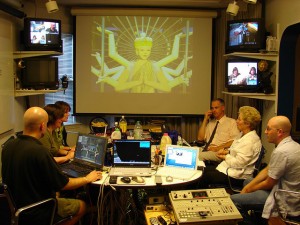 Microsoft’s resident business psychologist Bill Ives recently offered a sneak preview of a new Forrester report on “The Top 15 Technology Trends EA Should Watch: 2011 To 2013.”
Microsoft’s resident business psychologist Bill Ives recently offered a sneak preview of a new Forrester report on “The Top 15 Technology Trends EA Should Watch: 2011 To 2013.”
Forrester has some interesting technology terminology. An “EA,” for example, is an “enterprise architect,” a pretty slick new term for an entrepreneur, CEO, or the person who calls the shots — if not for the company, then for some significant division of the company, such as the IT department. IT as in “information technology.”
The Forrester report is focused on information technology rather than, say, manufacturing technology, which has some of its own pretty important trends. The Forrester report is prepared by analysts, and not just surveys, although this year they did ask business executives to rank 40 emerging technologies in terms of their importance in the coming years. The winners are:
- Mobile devices and applications
- Web 2.0 and social media
- Business intelligence
- Virtualized computing (Cloud computing)
- Computer and mobile security issues
- Software-as-a-service (SaaS)
One interesting aspect of the Forrester report is the timeline. Like Minitrends, it focuses on technology trends that are expected to pay off in the not too distant future. One of the trends that particularly peaked Ives’ interest at FASTforward is the way businesses are developing and using customer communities:
Organizations can use these customer communities to support market research and product development and gain insights from their market for real competitive advantage. I have recently talked with a number of vendors who are working to support this trend. It is predicted that this trend will have a high business impact and low IT impact and I would agree.
The Forrester report costs $499. Ives’ shrewd commentary on this and other matters important to Minitrends entrepreneurs is available free of charge at Microsoft’s FASTforward blog.
STEVE O’KEEFE
News Edtior, Minitrends Blog
Source: “Forrester on Top 15 Technology Trends Enterprise Architects Should Watch: 2011 To 2013,” FASTforward Blog, 10/18/10
Source: “The Top 15 Technology Trends EA Should Watch: 2011 To 2013,” Forrester Research, 10/14/10
Image by John E. Lester, used under its Creative Commons license.
Technology Forecast Favors Cloud Computing, Clean Tech
October 18, 2010
Legal services behemoth DLA Piper released a new Technology Leaders Forecast Survey, based on an email survey of thousands of technology company executives. Despite the fact that consulting group Gartner says cloud computing has peaked, DLA Piper’s forecast shows cloud computing as the number-one technology for growth potential in the near future:

Chart illustrating the most promising growth opportunities for the technology industry. Source: DLA Piper Technology Leaders Forecast Survey.
Second only to cloud computing is “clean tech.” Clean technology is one of the only areas where technology executives welcome government assistance in the marketplace. DLA Piper partner Craig Tighe explains why 84% of the business executives surveyed favor tax incentives and other government stimulus for clean tech, while only 23% think government should be involved in stimulating growth in tech projects:
The capital requirements and ROI timing for Clean Tech are not ideal for the current venture capital model. The infrastructure and financing requirements are massive, often in the hundreds of millions of dollars.
DLA Piper’s Technology Leaders Forecast Survey seems to focus mostly on political issues, such as whether tech execs think that the Bush tax cuts should be extended (yes), the U.S. will experience a double-dip recession (no), and whether they plan on boosting hiring (yes). The survey appears to have been rushed out ahead of the U.S. congressional elections in hopes of influencing public opinion on these issues. The previous DLA Piper Technology Leaders Forecast Survey was released just last April, after two years without a survey.
Most of the media coverage of the survey, such as San Francisco-based Ari Levy’s commentary for Bloomberg in the San Francisco Chronicle, focused on the difficulty of financing initial public offerings (IPOs). But there are some technology trends hidden in this highly political survey that are important for Minitrends entrepreneurs. Click on this link to download a PDF of the complete Technology Leaders Forecast Survey.
STEVE O’KEEFE
News Editor, Minitrends Blog
Source: “DLA Piper Technology Leaders Forecast Survey,” 10/12/10
Source: “Venture Funding Shrinks Leaving Scores of ‘Walking Dead’ Firms,” Bloomberg/San Francisco Chronicle, 10/11/10
Image courtesy DLA Piper, used under Fair Use: Commentary.

